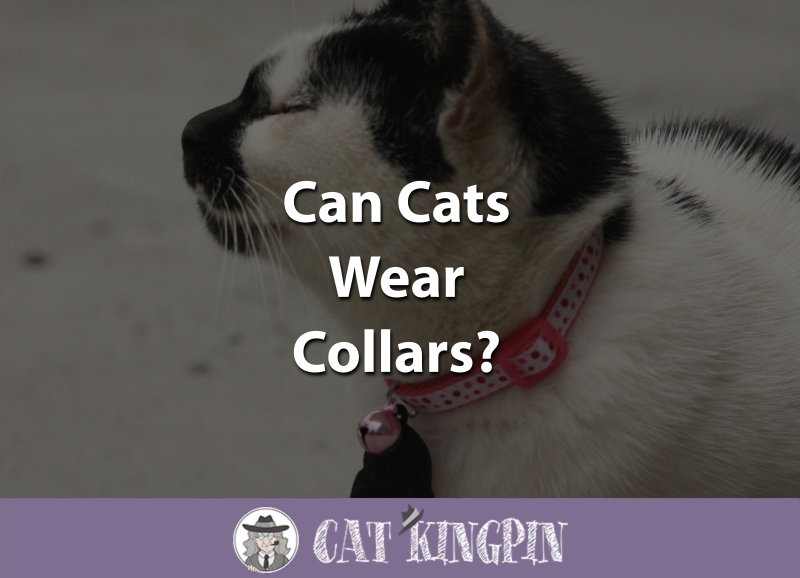Can Cats Wear Collars?
While dogs are traditionally the “collar wearers” of the animal kingdom, it’s equally important that we equip our feline friends with a safe collar that provides identification information.
Even if your cats rarely or never go outdoors, making sure that they are easily identifiable as pet cats will ensure that they are returned to you if they somehow get lost.
Other than for identification purposes, collars are also a very useful tool in feline pest control and can be a lifesaver (literally) for both indoor and outdoor cats.
In this article we’ll cover the following:
- Can Cats Wear Collars?
- Can Kittens Wear Collars?
- Do Indoor Cats Need To Wear Collars?
- How Do Cat Flea Collars Work?
- Can Kittens Wear Flea Collars?
Can Cats Wear Collars?
While you may think that cats don’t like to wear collars and will put up a fight if you try and force them, the truth is that roughly 3 out of 4 cats will tolerate wearing a collar, even if they aren’t accustomed to it since kittenhood. This is great news for cat owners!
Cat collars are important for identification purposes, even if your cat never goes outside. Cats are very fast and can escape in the blink of an eye if you accidentally leave the door or a window open.
In these cases, having a collar with your name and contact phone number can mean the difference between being found and staying lost. Most collars don’t come with an ID tag, so you will need to purchase one separately.
Choose one that is brightly-colored and can be personalized and engraved, such as Vet Recommended ID Tags. It’s never a bad idea to buy a few of them and have them on hand just in case one of them gets lost. And remember to update it if you move or change your phone number!
Cats who escape may be frightened and skittish and may not be easily caught. In these cases, having a visible collar will alert other people to the fact that the cat is a house cat and not feral cat.
There are a few important things to remember when choosing a collar for your cat:
- Purchasing an ill-fitting collar is a great way to ensure that your cat hates wearing it. Opt for the correct size (you should be able to easily slip two fingers between your cat’s neck and the collar at all times) and choose a collar made of comfortable material. Keep in mind that you may need to purchase multiple collars as your cat grows up.
- “Breakaway” collars are the safest option available, as they allow your cat to “break away” should they accidentally get their collar caught on something. “Breakaway” collars such as the Aspen Breakaway Collar may save your cat from accidentally suffocating or choking. This collar also has a bell, which is great for alerting you (and unsuspecting birds) to your cat’s presence.
This cat is trying on a collar for the first time. He doesn’t look thrilled, but remember that a collar is very important for your cat’s safety!
Can Kittens Wear Collars?
You should absolutely get your kitten accustomed to wearing a collar from a young age. Cats who wear collars as kittens are much less likely to try and take them off as adults.
It’s important not to force your kitten to wear a collar when they are young. If putting on the collar becomes a battle between you and your kitten, they are likely to run and hide as soon as they see it.
Instead, introduce the collar slowly and kindly. Offer your kitten tons of praise and treats, and only put the collar on for a few moments at a time, at least initially.
Gradually your kitten will build up a tolerance to the foreign sensation of having something permanently around their neck, and you’ll be able to leave it on for longer and longer periods of time.
Before you know it your kitten won’t even notice that they’re wearing the collar.
For your kitten’s first collar, you should opt for a breakaway collar that is elasticized and has a bell, such as the Coastal Pet Kitten collar. The elasticity will provide plenty of comfort, and the bell and breakaway features are important safety measures for curious kittens.
Do Indoor Cats Need To Wear Collars?
Indoor cats should absolutely wear collars. Even the most content housecat may occasionally feel a bit of wanderlust, and cats are very sneaky and fast when they want to be.
While there are many precautions you can take to keep your cat from escaping, none of them are foolproof, and having a collar and up-to-date ID tag is extremely important in case your cat escapes and gets lost.
When your cat receives their rabies shot, your vet will likely give you a small medallion that can be attached to your cat’s collar and serves as proof of vaccination. This is another excellent reason to make your indoor cat wear a collar.
Indoor cats are also not immune to fleas and ticks, which is where flea collars come in.
How Do Cat Flea Collars Work?
Flea collars are a means of pest control for both indoor and outdoor cats. They are usually well-tolerated, relatively inexpensive, and last for months at a time.
Contrary to popular belief, both indoor and outdoor cats can get fleas, so it’s important to protect your cat even if they spend the majority of their time indoors.
Flea collars are usually made of rubber or plastic and contain a chemical that both repels and kills fleas and ticks. You simply place it on your cat’s neck and let the collar do its job.
The best flea collars are ones that offer long-term pest control coverage, such as the Seresto collar, which provides up to 8 months of protection against fleas and ticks. The Seresto collar also has a “breakaway” safety function, which will allow your cat to escape from the collar should they accidentally get stuck somewhere, and is suitable for adult cats of all weights.
Putting a flea collar on your cat is one of the easiest ways to protect them against fleas and ticks. This video shows you just how simple it can be (especially if your cat is already accustomed to wearing a regular collar).
Can Kittens Wear Flea Collars?
Yes, unlike topical flea and tick medications, flea collars are generally safe for kittens of all ages.
While you should consult your veterinarian before using a flea collar on kittens under 12 weeks of age, it’s very important to take adequate steps to protect your kitten from fleas and ticks.
Fleas in particular can pose a real threat to a young kitten’s health. Because they are small and vulnerable, a flea infestation can wreak havoc on your kitten’s health.
Blood loss due to flea infestations can cause anemia, and your kitten can contract tapeworms if they manage to ingest a flea. Severe flea infestations can even lead to death in young kittens, so it’s very important to protect them.
When choosing which flea collar to use for your kitten once they reach 12 weeks of age, be very careful to choose a brand that has a breakaway feature, lasts for months, and make sure not to accidentally buy a flea collar that is intended for canine use.
So, can cats wear collars?
Yes, cats can definitely wear collars, and they definitely should!
Regular collars and flea collars both provide your cat with protection. The first protects them from becoming lost and the second provides important protection against fleas and ticks.
When choosing a regular collar for your cat or kitten, take care to choose one that is comfortable and is easy to escape from if they get stuck, such as the Aspen Breakaway Collar.
You should look for a flea collar that has a breakaway feature as well, such as the Seresto collar. The Seresto collar also lasts up to eight months and is suitable for cats of all sizes and kittens over 12 weeks old.
How did you train your cat to wear a collar? Was it easy or difficult? Do you have tips for flea and tick collars? Let us know in the comments!







